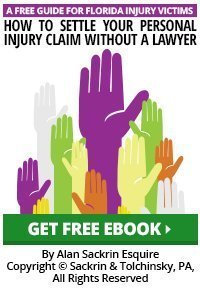Read case summaries where Judges found and did not find that these business owners should have known about a dangerous condition on their premises.
To recover injuries in a Florida slip and fall, a victim must prove that the owner of the premises had actual or constructive notice of the dangerous condition. Where there is no evidence that the owner had actual notice of the dangerous condition, the victim must proceed on the theory that the defendant had constructive notice.
In Florida, constructive notice is shown by proving the condition existed for a length of time that the owner, exercising ordinary care, should have known about it or the condition occurred with such regularity that it was foreseeable that a dangerous condition would exist.
Florida Has Specific Requirements To Prove Constructive Notice In A Slip and Fall When There Is Water or Other Transitory Foreign Substance on the Floor
According to Florida statutory law, If a person slips and falls on a transitory foreign substance in a business establishment, constructive knowledge may be proven by circumstantial evidence showing that: (1) the dangerous condition existed for such a length of time that, in the exercise of ordinary care, the business establishment should have known of the condition; or (2) the condition occurred with regularity and was therefore foreseeable.
Thus, in a slip and fall lawsuit, the court will direct a verdict for the defendant where the plaintiff fails to establish the defendant’s constructive notice of the dangerous condition.
Read: What’s Your Case Worth?
Examples Where The Court Did Not Find The Owner Had Constructive Notice of A Dangerous Condition
1. – WINN–DIXIE STORES, INC v. Janet MAZZIE, and Jerry Mazzie 707 So.2d 927
In this case, there was testimony from the store employee who was previously restocking the deli refrigerator in the area where the plaintiff slipped and fell that he checked the floor before he left the area and that everything was clear and fine. Additionally, another Winn-Dixie employee testified that a zone check was conducted ten minutes before the plaintiff fell revealing no foreign matter on the floor. And, two customers who witnessed the fall testified that they observed nothing on the floor. In fact, one of the customers testified that she crawled around on the floor while helping the plaintiff and specifically checked for any substance on the floor so that no one else would be injured, but she saw nothing. However, a paramedic who assisted the plaintiff after the accident testified that he saw a puddle of water the size of a dinner plate on the floor next to where the plaintiff had fallen.
Based on these facts, the appellate court held that there was insufficient evidence to create an inference that Winn-Dixie had constructive notice of any dangerous condition and reversed the final judgment in favor of the plaintiff and directed the trial court to enter a final summary judgment for Winn-Dixie.
2. – Naushad HUSSAIN and Raana Naushad v. WINN DIXIE STORES, INC. 765 So.2d 141
Here, no one saw the plaintiff fall, and the yolk of the egg which caused the plaintiff to slip had not crusted or aged from being left on the floor for a long period of time. In fact, the yolk was fresh and runny. Furthermore, an employee testified that he had mopped the floors at least thirty minutes before the plaintiff fell and saw nothing that would cause the plaintiff to fall.
As a result, the court found “because there was no proof or suggestion that a store employee caused the egg to fall where it was, or that Raana did, or that anyone actually saw the egg before Raana fell,” that Winn Dixie could not be charged with constructive knowledge of a dangerous condition.
See: Winn Dixie Cases Settled By Alan (on our main website)
Example of Where The Court Did Find The Owner Had Constructive Notice of A Dangerous Condition
Barbara WOODS and Anthony Woods v. WINN DIXIE STORES, INC 621 So.2d 710
In this case, the plaintiff testified, and a Winn Dixies employee testified, that there was dirt, scuffs or skid marks in the substance that caused the plaintiff to fall. Based on this information, the jury found that Winn Dixie had constructive notice of this dangerous condition and neglected to correct it. The appellate court found that the inferences made from the circumstantial evidence were reasonable and supported the jury’s verdict. Thus, the jury verdict of finding Winn Dixie 75% at fault was reinstated.
Are You a Victim of a Slip and Fall?
The last thing anyone wants is to be re-victimized by a negligent party making a low ball offer. A good piece of advice if you have been injured in a slip and fall is to speak with an experienced lawyer before you file a claim to learn about some of the issues that can arise when seeking compensation, including the amount of damages you can recover and the amount of time it takes to get a settlement. Most personal injury lawyers, like Alan Sackrin, will offer a free initial consultation (over the phone or in-person) to answer your questions and explain your options.
Related:
_______________
 Do you have questions or comments? Then please feel free to send Alan an email or call him now at (954) 458-8655.
Do you have questions or comments? Then please feel free to send Alan an email or call him now at (954) 458-8655.
If you found this information helpful, please share this article and bookmark it for your future reference.
